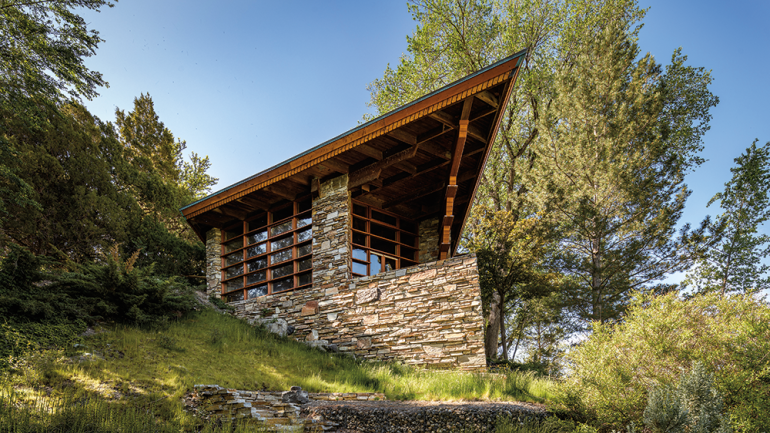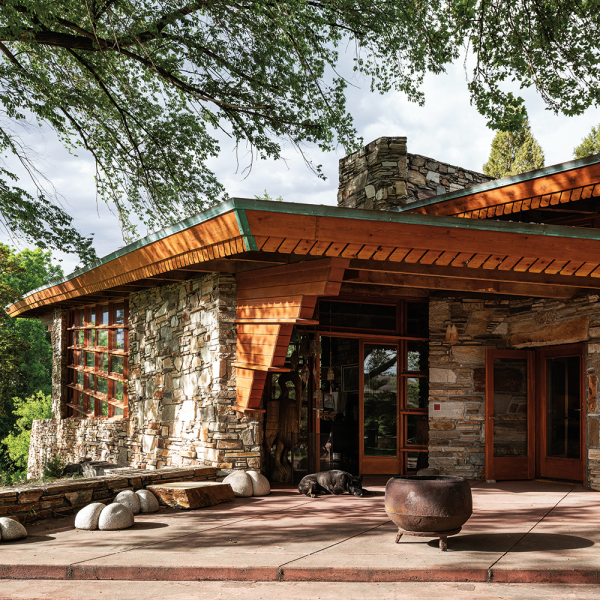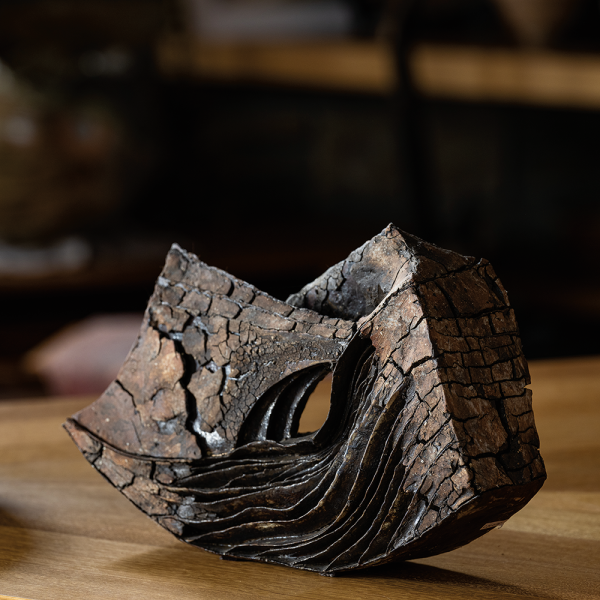A Match Made in Idaho
A Match Made in Idaho
In 2017, on a trip to Japan with the Frank Lloyd Wright Trust, architectural writer Henry Whiting encountered the work of the ceramist Shiro Tsujimura at Kou Gallery in Kyoto. He noticed in particular a vase with a pale spot on its surface (he later learned it had been masked by a small cup in the kiln). “That yellow eye kept following me as I moved around the space,” he says. “It was as if the pot chose me.”
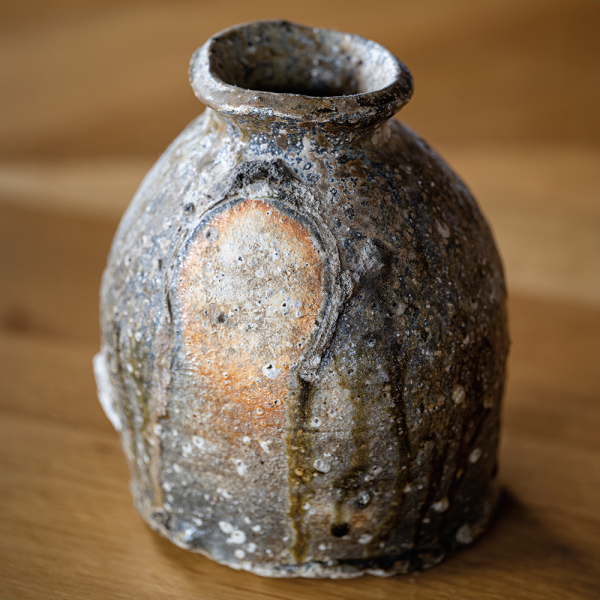
Henry Whiting says seeing this 8-by-7-in. Shigaraki clay vase by Shiro Tsujimura, with its yellow “eye,” changed his life.

Whiting based his selection of Shigaraki clay ceramics—such as this 11-by-14-in. vase by Shiro Tsujimura—on the rockwork’s color value and texture.
The Build:
An Artist, His Wife, an Architect, a Stonemason
The story of Teater’s Knoll is a tale of art and artisanship, ruin and resurrection. The narrative begins with Archie Boyd Teater, one of the 20th-century’s most prominent Western-style artists and one of its most prolific; he is thought to have created more than 4,000 paintings over the course of his career. Born in Boise in 1901, Teater was a restless and enterprising soul. As a teenager he was kicked out of school for his incessant doodling, so he took to an outdoor existence, fishing for salmon, trapping game, and drawing and painting whatever he saw. By the time he was 20, he’d sold enough mink and muskrat pelts to afford brief spells of tuition at the Portland Art Museum.

This masonry wall was the last created by Kent Hale, the building’s original stonemason, in 1998 when he was 78 years old.
To me, the tea bowls make the architectural space more beautiful, and vice versa.
Henry Whiting
It was the only formal training he ever received. Teater was effectively self-taught, and his style remained untouched by modernist currents. It has something better than sophistication, though: a vivid, you-are-there reportorial style that brings his subjects to life—the mining and logging camps where he picked up occasional work, the glorious Sawtooth and Grand Teton mountain ranges, and life in downtown Jackson Hole, Wyoming, where he spent much of his time.
It was in Jackson Hole that he met his future wife, Patricia Wilson, who would play a decisive role in both his career and the creation of Teater’s Knoll. An amateur artist in her own right, she had a true gift for promotion and put all her talents and energy into publicizing her husband’s work. Patricia had been raised in Oak Park, Illinois, where Wright conducted his early career, and it was her idea to commission him to create a studio in the dramatic setting of the Hagerman Valley, where Archie had been intermittently living in an abandoned bootlegger’s shack.
The Teaters purchased a two-acre piece of land up on a high knoll for $125. Shortly afterward, Patricia gathered her courage and wrote to Wright directly: “Is there any possibility of having some student of yours do an architectural plan—the only way we could compensate him would be to pay with a painting in oils by Mr. Teater.” She specified an upper limit to their construction budget: $6,000.
Amazingly, the world-famous architect not only responded to this modest overture but suggested a meeting to discuss the prospect. This was duly arranged at Taliesin West in March 1952. Wright informed the presumably dazed but ecstatic couple that he himself would be taking on the commission. By September, they had received a floor plan and elevation. It showed a compact but geometrically complex structure based on intersecting equilateral triangles, with an exterior of horizontally laid masonry—a material expression not dissimilar from what he’d used in his masterpiece, Fallingwater. Wright also specified that the stone be sourced locally, as was his customary practice. The Teaters wrote back immediately and enthusiastically: “. . . everyone here is awestruck. The idea of building such a structure seems incredible to the natives who tell us wont [sic] live long enough to get it built!” They also added, encouragingly, “We have quite a lot of rock.”

Teater’s Knoll is perched 300 feet above the Snake River. Painter Archie Teater chose this location for its views and the ever-present sound of the rapids below.

A blueprint of Wright’s original floor plan for Teater’s Knoll.
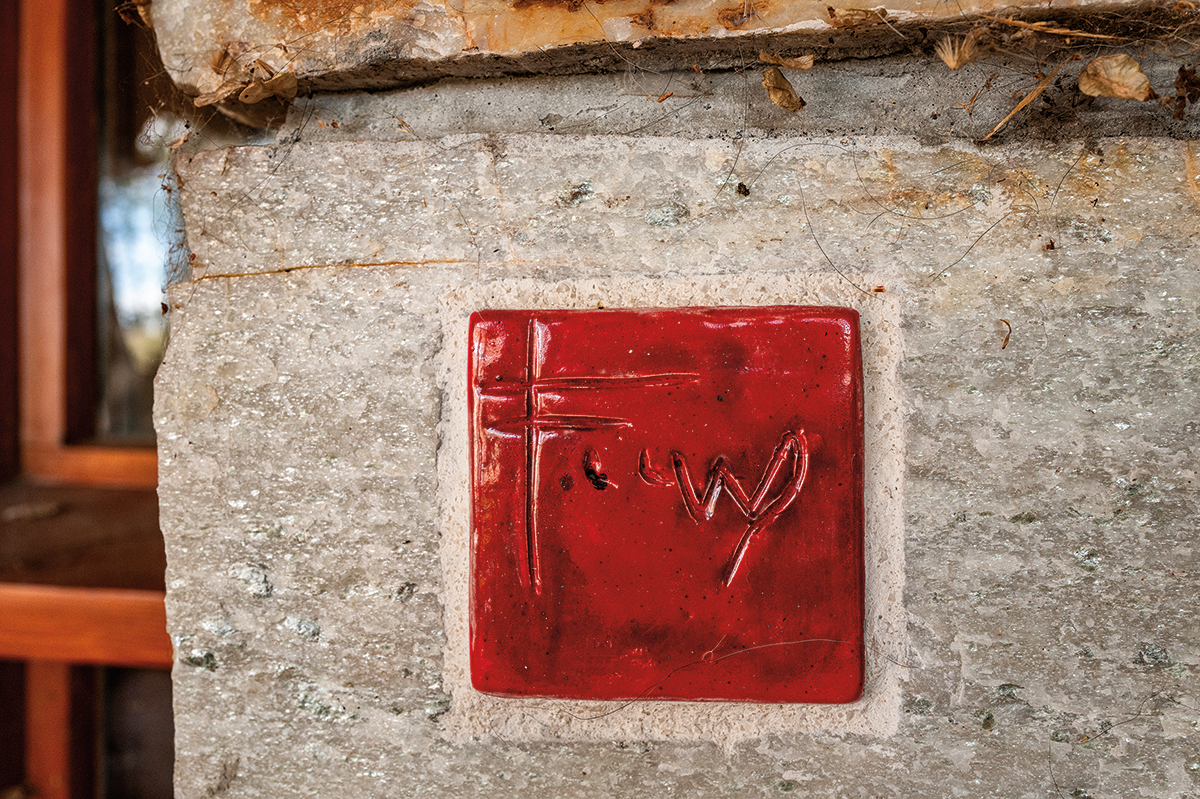
Approximately 60 of these 3.5-square-inch Frank Lloyd Wright signture tiles exist on Wright buildings. This one was given to Whiting by his father-in-law, Randall Fawcett, an original client of Wright’s.
Here another important character enters the story: a young mason by the name of Kent Hale, who lived in Oakley, about 80 miles to the southeast. It seems likely that Patricia Teater viewed the studio project at least partly as a marketing investment; Archie’s paintings could only grow in stature through association with Wright. Hale made a similar calculation. He had studied (and greatly admired) Fallingwater in his college landscape architecture courses, but he also reckoned that his involvement in the project would be a terrific calling card for his new business.
Hale got the job and proved to be the perfect man for it. He had already experimented with local quartzite—weathered Oakley stone that was collected from the surface of the land—having used it to build a fireplace for his family home. Teater’s Knoll would be a vastly more challenging project. The exterior has six 60- and 120-degree angles, each of which gradually tapers upward from the ground. It features a commanding hearth—which Wright always viewed as the symbolic center of a home—and the whole building is set upon a steep grade, so it is only 6 feet tall at one end but 40 at the other. Undaunted by these demanding parameters, Hale spent the winter quarrying stone and laid his first piece in February 1954. Meanwhile, other local builders, under the supervision of Wright’s apprentices, were setting to work on the house’s extraordinary roof, which has deep overhangs along its edges and a dramatic 25-foot cantilever, pointing over the valley like a compass or an arrowhead.
Unfortunately, as the Teaters poured time and money into the project, they began to run out of patience—especially with Kent Hale. There were disagreements about payment, delays, and materials. Eventually, with little justification, they dismissed him, and other masons with no understanding of Wright’s aesthetic were brought in to complete the stonework. It took three years, but the tiny, powerful building was finally completed at the end of 1957. The Teaters would live there on and off for nearly 20 years, until Archie’s failing health prompted the couple to move to Carmel, California. He died in 1978, and Patricia three years later.
The Restoration:
A Writer-Collector and the Return of the Stonemason
Meanwhile, Henry Whiting was falling in love with Frank Lloyd Wright’s architecture, little suspecting the central role it would occupy in his life. He hails from Midland, Michigan, which is known for two things: it is the headquarters of Dow Chemical and has the largest concentration of buildings by the modernist architect Alden B. Dow, a former member of Wright’s Taliesin Fellowship, who was also Whiting’s great uncle and the son of the chemical company’s founder.
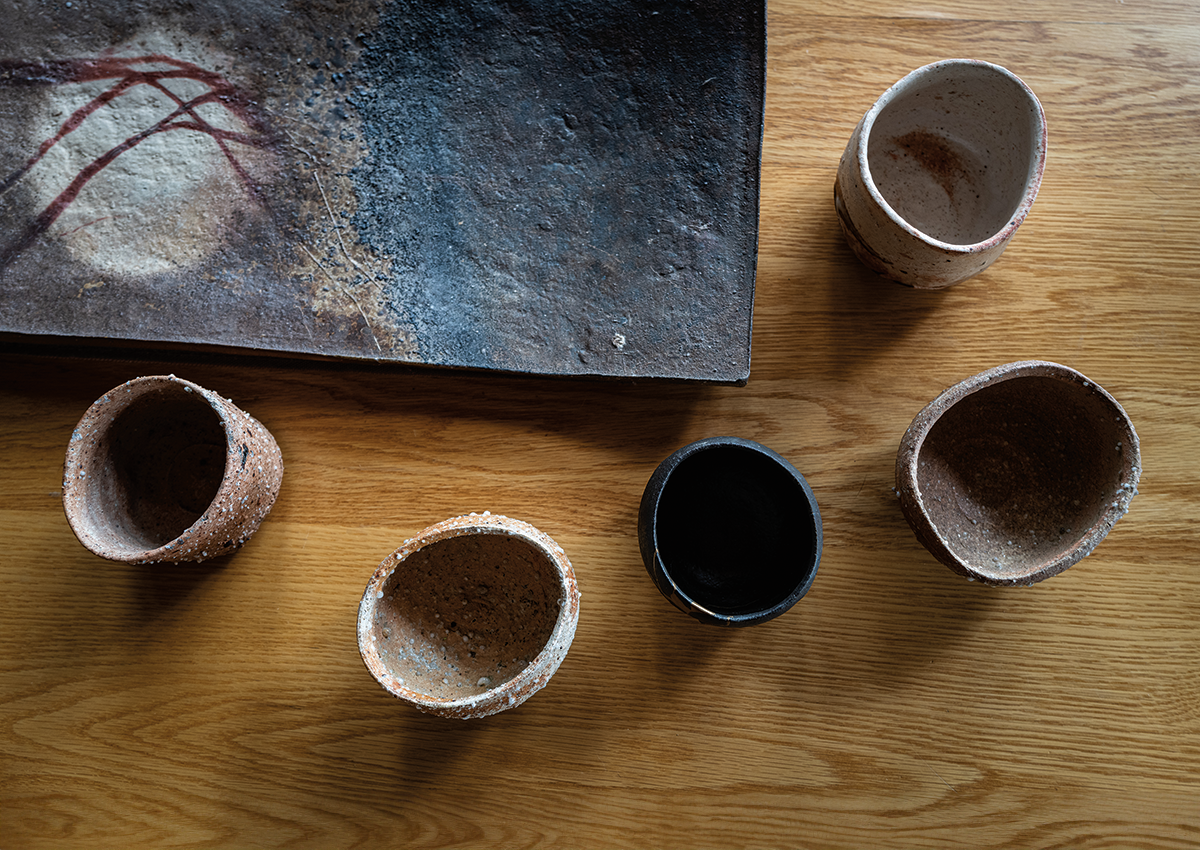
Whiting grew up quite literally surrounded by Dow’s work: the hospital where he was born, the house where he lived, and his junior high school were all designed by Dow. He also attended high school at Cranbrook School, which is next door to Cranbrook Academy of Art—a campus that includes Saarinen House, Eliel Saarinen’s “total work of art”—and then went on to the University of Wisconsin–Madison (not far from Taliesin), where he was able to study Wright’s architecture in depth with the historian John Kienitz. Upon graduation, Whiting happened to get a job in Idaho working for architect Neil Morrison Wright (not a relation of Frank Lloyd Wright, but a great admirer of his work). He naturally sought out Teater’s Knoll, which he knew only from published photographs.
Whiting was both intrigued and shocked when he first visited the site in summer 1977. The building was abandoned and surrounded by a fence that was topped, prisonlike, with barbed wire. He tried to contact the Teaters, without success. Years went by; the place deteriorated further. Finally, in 1982, he learned that the house was on the market. Wasting no time, he went to a viewing and stepped inside.
It was a chaotic scene. The house had been pillaged of Archie’s work, there was dust everywhere, and it was freezing cold—the place hadn’t been heated in years. The dramatic cantilevers had begun to fail and were propped up, bizarrely, by jury-rigged TV antennae. But Wright’s furniture, including a set of high-backed dining chairs, was still in place. And even in its sorry state, the building was breathtakingly beautiful.
Whiting, all of 26 years old at the time, conceived a wild plan: he would bring Teater’s Knoll back to Wright’s original vision. He bought the house, moved in, and got the fireplace going. Right away he discovered a cache of drawings and documents, including a box marked “Hale Mess,” which held the sad story of disintegrating relations between the Teaters and their talented mason. He could see for himself the disparity in quality in the house’s stonework and realized how gifted Kent Hale must have been. So he reached out—Hale was still living and working in Oakley—and asked him to join forces, effectively completing the job that had started his career. Full circles like this rarely come around in life, much less in architectural preservation.

Frank Lloyd Wright’s original dining table and chairs for Teater’s Knoll. A “thousand paper cranes” made by the nieces and nephews of Whiting’s late wife, sculptor Lynn Fawcett Whiting. A watercolor portrait of the Whitings by their neighbor, Masako Robbins.
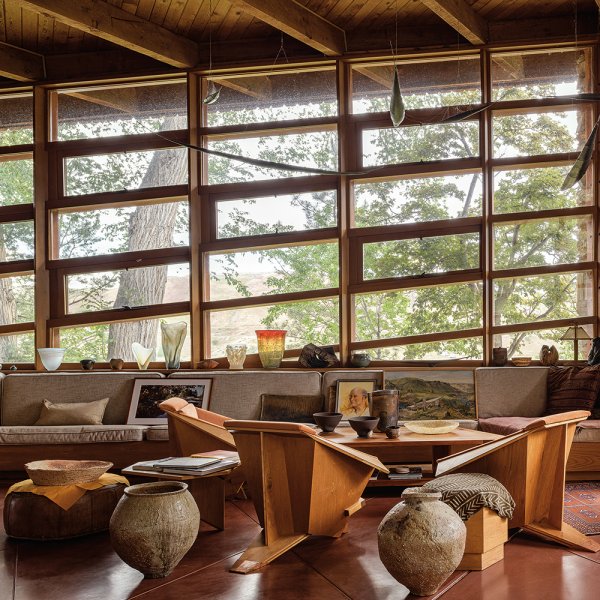
Wright designed the Origami Chairs in 1949, and Whiting had them made in 1984 from plans left in the studio. Shiro Tsujimura made the large bowl on top of the left ottoman in 2023, as well as the two vessels sitting on the floor. On the table are two medium-sized bowls by Richard DeVore. A landscape painted by Archie Teater rests on the couch.
“One of the unexpected revelations of the tea bowls comes when I’m sitting with them, holding them in my hands, and doing the same kind of contemplation of their interior,” Whiting continues. “This is a deeper way of looking at how the ceramics affect my life, and simple as it sounds, I’ve spent hundreds of hours in this contemplation. To me, the tea bowls make the architectural space more beautiful, and vice versa. I, of course, love holding them and feeling their tactility, just as I love touching the rock walls, visually or tactilely, of Teater’s Knoll.”
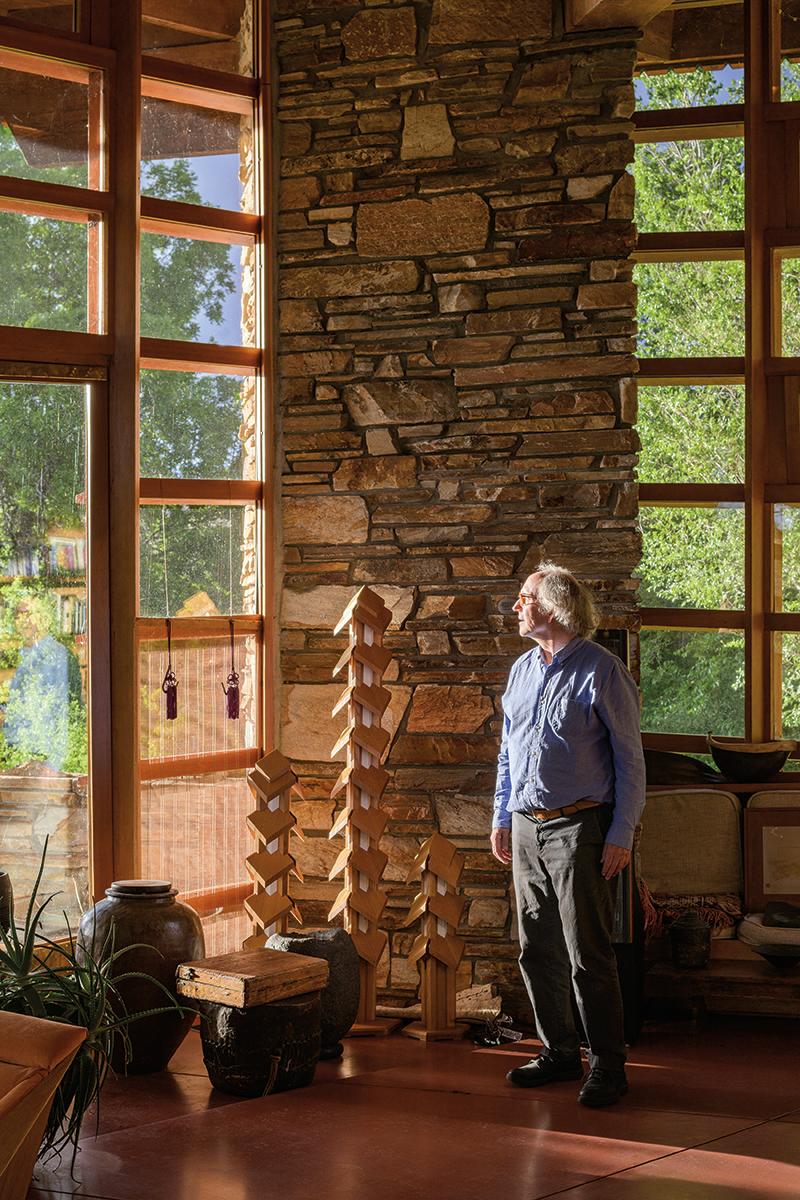
Whiting stands in front of “some of mason Kent Hale’s best work” near the prow of Teater’s Knoll. Whiting designed the “pagoda lanterns” next to him in 1985; they were built in 2018 by woodworker Paul Bates, who was also part of the 1982–83 restoration.
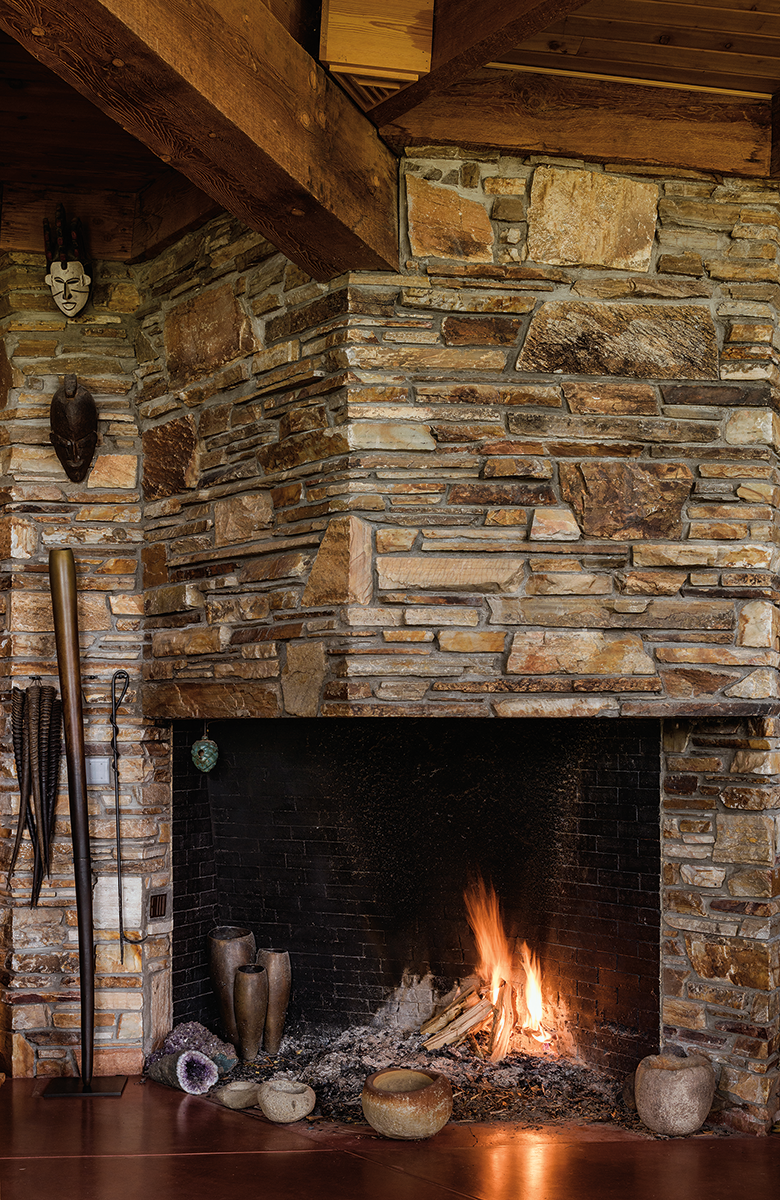
Whiting agrees with many who’ve claimed Wright’s fireplaces—such as this 5-by-9-ft. design built by Hale—were like tokonomas, dedicated spaces for displaying art in a Japanese house. The bronze vessels inside and outside the fireplace were made by Fawcett Whiting. The couple purchased the Native American ceramic vessels inside the fireplace in Idaho and California.
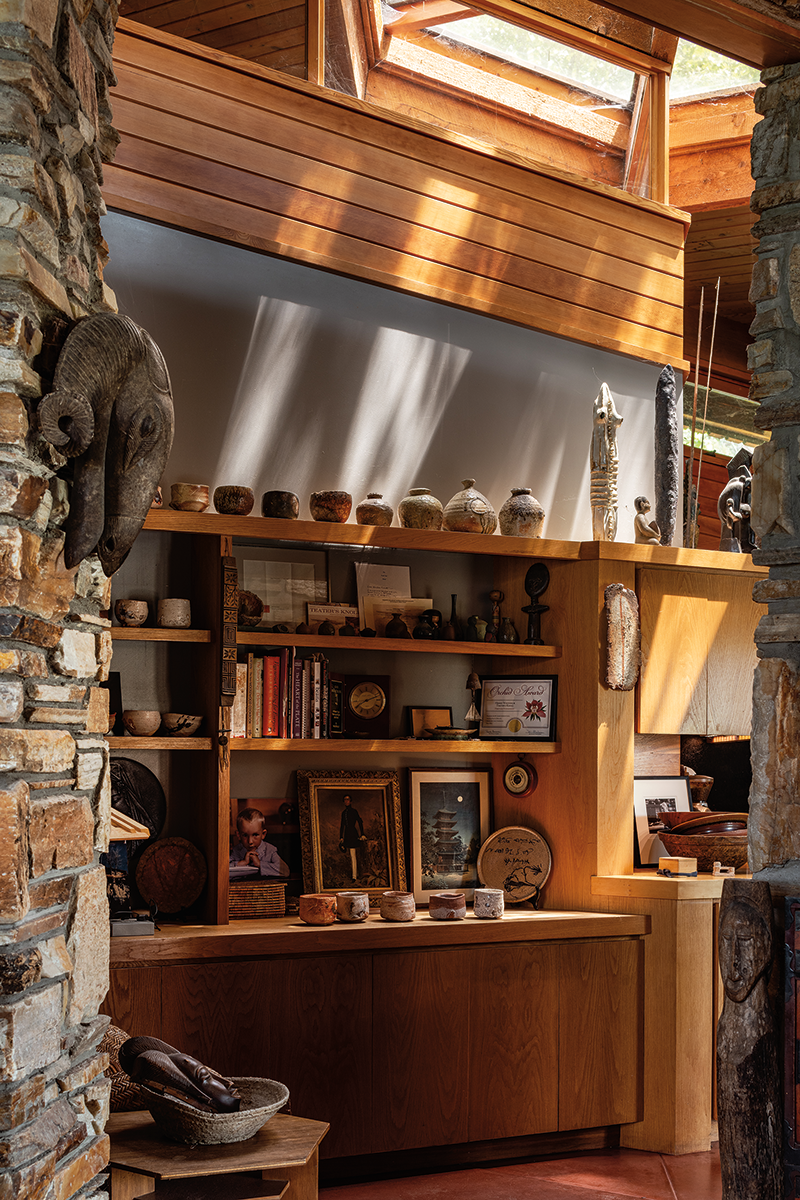
A view into the library and kitchen, which Whiting redesigned in 1982, reveals how he displays his collection of tea bowls and ceramics.
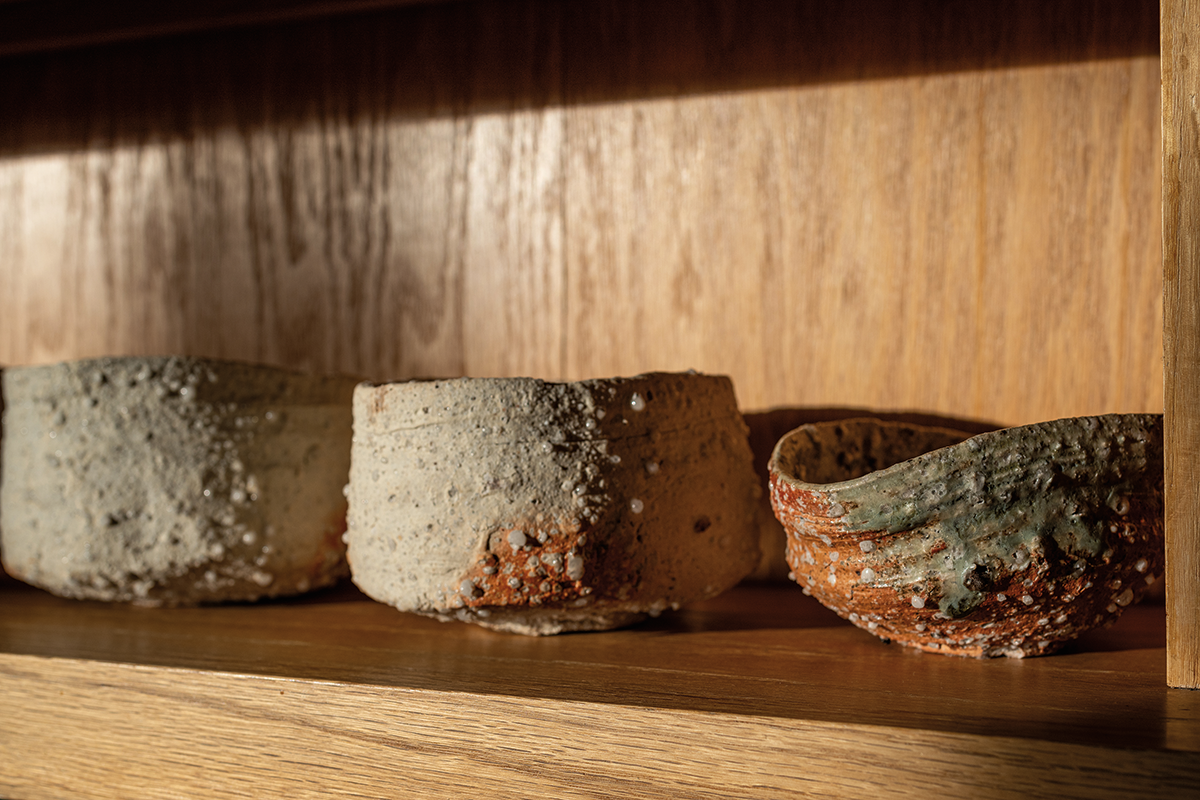
White Shigaraki tea bowls by Tsujimura.


